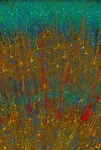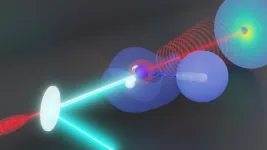(Press-News.org) Patients with X-linked severe combined immunodeficiency disorder (SCID-X1), sometimes called “bubble boy disease,” are born with a defective gene that prevents them from producing immune cells. Gene therapy from St. Jude Children’s Research Hospital restored the immune system in multiple infants with SCID-X1 in 2019 by supplying copies of the corrected gene. Through ongoing efforts to monitor patient safety, St. Jude scientists recently documented where the gene copies integrate into patient DNA, providing a foundation to understand the biology and safety of using lentiviral vectors. The findings were published today in Science Advances.
“We now have a robust pipeline to monitor the safety of lentiviral gene therapies,” said senior co-corresponding author Jiyang Yu, Ph.D., St. Jude Department of Computational Biology interim chair. “This really gives hope to patients with genetic diseases that can be cured by lentiviral gene therapy. It looks like we cured bubble boy disease safely in these patients.” The St. Jude team published the entire computational pipeline together with the manuscript.
Several years after treatment, the St. Jude lentiviral gene therapy for SCID-X1 appears both effective and safe, unlike earlier retroviral approaches. The researchers identified where the gene was added to patients’ DNA and why the vector integrated in that particular place. Scientists previously knew that lentiviral gene therapies integrated into different areas of DNA that appeared safer than earlier technologies, but they could not address why.
3D genome structure holds the key to SCID-X1 gene therapy
The scientists found that copies of the new, corrected gene had been inserted into certain genomic hotspots for the patients in the study. The reason was deceptively simple: From a 3D structural perspective, the hotspots are regions the lentiviral vector first encounters after entering the cell’s nucleus through a channel called a nuclear pore.
“It’s like someone coming into a room and taking the first available seat near the door,” said co-corresponding Stephen Gottschalk, M.D., St. Jude Department of Bone Marrow Transplantation and Cellular Therapy chair. “The room is the nucleus. The seats are these DNA elements right near the door of the nuclear pore. That never occurred to me before this study, but it’s a very simple principle in the end.”
The St. Jude group found that the integration site pattern of the gene therapy into patient cells shed light on the safety and efficacy of the approach.
“We performed a comprehensive single-cell multi-omic analysis of this gene therapy to understand whether a functional copy of the corrected gene was in patient cells, to what extent the gene was expressed, and the chromatin organization at a single-cell level,” said first author Koon-Kiu Yan, Ph.D., St. Jude Department of Computational Biology. “Before this study, we could measure the general gene expression of a bulk group of cells. But with bone marrow samples from two patients, we saw at a single-cell level which genes were expressed in which cell types.”
Using that single-cell analysis, along with their other work, Yan showed that the safety and efficacy of treatment are also related to integration into compartments near the nuclear pore. Previous gene therapy efforts integrated into promoters near to or directly into oncogenes, ultimately causing cancer. The lentiviral vector used by St. Jude selectively avoids promoters without disrupting oncogenes, improving treatment safety. The same pattern was observed with a lentiviral gene therapy used to create chimeric antigen receptor (CAR) T cells, suggesting that the phenomenon may be a general mechanism not restricted to the SCID-X1 vector.
“The integration pattern data could serve as a map of potentially safe integration sites,” Yu and Gottschalk explained. “The single-cell analysis is like deep cartography, a map with a near pixel-perfect resolution. The large number of integration sites could be used as a safety reference for future lentiviral gene therapies.”
One case was especially notable: the patient who required a second dose of the gene therapy to achieve a cure was found to have a different integration pattern than the patients who had responded to the first dose. After receiving the second dose, the patient’s integration pattern resembled the others’, and the therapy was effective. This study provides a foundation for understanding differences in treatment response so that future gene therapies may be improved.
Authors and funding
The study’s other authors are Jose Condori, Zhijun Ma, Jean-Yves Metais, Bensheng Ju, Liang Ding, Yogesh Dhungana, Lance Palmer, Deanna Langfitt, Francesca Ferrara, Robert Throm, Hao Shi, Isabel Risch, Sheetal Bhatara, Bridget Shaner, Timothy Lockey, Aimee Talleur, John Easton, Michael Meagher, Sheng Zhou and Ewelina Mamcarz, all of St. Jude; and Jennifer Puck and Morton Cowan, University of California San Francisco Benioff Children’s Hospital.
The study was supported by grants from the National Institutes of Health (R01-GM13482, P01-HL053749 and U54-AI082973), National Institute of Allergy and Infectious Diseases (U54-AI082973), California Institute of Regenerative Medicine (CLIN2-09504 and CLIN2-10830), National Cancer Institute Comprehensive Cancer Center (P30CA021765), Assisi Foundation of Memphis and ALSAC, the fundraising and awareness organization of St. Jude.
St. Jude Media Relations Contacts
Michael Sheffield
Desk: (901) 595-0221
Cell: (901) 379-6072
michael.sheffield@stjude.org
media@stjude.org
Rae Lyn Rushing
Cell: (901) 686-2597
raelyn.rushing@stjude.org
media@stjude.org
St. Jude Children's Research Hospital
St. Jude Children's Research Hospital is leading the way the world understands, treats and cures childhood cancer, sickle cell disease and other life-threatening disorders. It is the only National Cancer Institute-designated Comprehensive Cancer Center devoted solely to children. Treatments developed at St. Jude have helped push the overall childhood cancer survival rate from 20% to 80% since the hospital opened more than 60 years ago. St. Jude shares the breakthroughs it makes to help doctors and researchers at local hospitals and cancer centers around the world improve the quality of treatment and care for even more children. To learn more, visit stjude.org, read St. Jude Progress blog, and follow St. Jude on social media at @stjuderesearch.
END
3D genome architecture influences SCID-X1 gene therapy success
Scientists at St. Jude Children’s Research Hospital have pinpointed where in DNA the gene therapy for successful and safe cures of infants with X-linked severe combined immunodeficiency integrates
2023-10-06
ELSE PRESS RELEASES FROM THIS DATE:
Human brain seems impossible to map. What if we started with mice?
2023-10-06
The human brain is a tangled highway of wires emanating from nearly 100 billion neurons, all of which communicate across trillions of junctions called synapses. “Depressingly complex,” Harvard neuroscientist Jeff Lichtman calls it. The only way to understand this highway, says Lichtman, is to create a map.
Lichtman, the Jeremy R. Knowles Professor of Molecular and Cellular Biology, has spent several decades generating such maps, and in doing so has pioneered a field known as “connectomics.” ...
Study validates pyrvinium as treatment to prevent stomach cancer
2023-10-06
A study published Oct. 4 in Gastroenterology further validates that pyrvinium, a drug that has been used for decades for intestinal pinworms, can be repurposed as a preventative treatment for stomach cancer.
Eunyoung Choi, PhD, assistant professor of Surgery, and colleagues have demonstrated in human organoids and mouse models that the drug induces cell death in precancerous lesions. Pyrvinium blockades both the MEK/ERK and STAT3 signaling pathways. In another study she led, which was published last year in Gastroenterology, the researchers demonstrated that pyrvinium blocked regeneration of dysplastic ...
Researchers catch protons in the act of dissociation with SLAC’s ultrafast 'electron camera'
2023-10-06
Scientists have caught fast-moving hydrogen atoms – the keys to countless biological and chemical reactions – in action.
A team led by researchers at the Department of Energy’s SLAC National Accelerator Laboratory and Stanford University used ultrafast electron diffraction (UED) to record the motion of hydrogen atoms within ammonia molecules. Others had theorized they could track hydrogen atoms with electron diffraction, but until now nobody had done the experiment successfully.
The results, published October 5 in Physical ...
Scientists investigate Grand Canyon's ancient past to predict future climate impacts
2023-10-06
The Grand Canyon’s valleys and millions of years of rock layers spanning Earth’s history have earned it a designation as one of the Seven Natural Wonders of the World. But, according to a new UNLV and University of New Mexico study, its marvels extend to vast cave systems that lie beneath the surface, which just might hold clues to better understand the future of climate change — by studying nature’s past.
A research team led by UNLV paleoclimatologist and Professor Matthew Lachniet that included the University of New Mexico Department of Earth & Planetary Sciences Distinguished Professor Yemane Asmerom and Research Scientist Victor Polyak and other ...
ESMO Congress 2023
2023-10-06
Lugano, Switzerland, 6 October 2023 – Under the promise to “Disseminating innovative research for optimal cancer care” as this year’s tagline reads, the ESMO Congress 2023 will be held in Madrid between 20-24 October 2023 with a virtual component to allow as many people as possible to attend.
From a keynote lecture pinpointing the hallmarks of cancer in the current year through the reinforced commitment towards more academic input in the drug development process for better cancer care, and then further down to the dramatic scenarios brought by the too many situations of crisis in the world which have an unbearable impact ...
ORNL, University of Texas Rio Grande Valley partner to provide students research, mentorship opportunities
2023-10-06
The Department of Energy’s Oak Ridge National Laboratory and the University of Texas Rio Grande Valley, known as UTRGV, have signed a memorandum of understanding to strengthen research cooperation and establish a collaborative program for undergraduate research and education, further cementing relationships and collaboration between the lab and minority-serving institutions. This partnership builds a pathway for students to pursue science, technology, engineering and mathematics, or STEM, careers through DOE by complementing ...
Lurbinectedin for Neuroendocrine Tumors (NETs)
2023-10-06
“Several ongoing trials hope to further elucidate the role of lurbinectedin in highgrade neuroendocrine neoplasms [...]”
BUFFALO, NY- October 6, 2023 – A new editorial paper was published in Oncoscience (Volume 10) on June 14, 2023, entitled, “Lurbinectedin, a DNA minor groove inhibitor for neuroendocrine neoplasms beyond small cell lung cancer.”
In their new editorial, researchers Deepak Bhamidipati and Vivek Subbiah from the Sarah Cannon Research Institute discuss lurbinectedin as a method to treat neuroendocrine tumors (NETs). NETs encompass a variety ...
Clinical trial reveals benefits of inhaled nitric oxide for patients with respiratory failure due to COVID-19 pneumonia
2023-10-06
Key Takeaways
Researchers have posted the results of a multisystem phase II clinical trial of patients with COVID-19 and respiratory failure
Patients who received inhaled nitric oxide had improved blood oxygen levels and fewer risks of long-term sensory and motor neurologic symptoms
They also experienced a faster reduction of viral load in sputum and blood
BOSTON – Inhaled nitric oxide gas widens blood vessels in the lungs and is used to treat severe cardio-pulmonary conditions in newborns and adults.
A recent multicenter international ...
nTIDE September 2023 Jobs Report: Employment trend holds steady at historic highs through early autumn for people with disabilities
2023-10-06
East Hanover, NJ – October 6, 2023 –The labor force participation and employment-to-population ratio have held relatively steady throughout the summer and into the fall for people with disabilities, while percentages for people without disabilities may have maxed out at their pre-pandemic baseline, according to today’s National Trends in Disability Employment – semi-monthly update (nTIDE), issued by Kessler Foundation and the University of New Hampshire’s Institute on Disability (UNH-IOD). In comparison, the employment-to-population ratio for people without disabilities remained flat with no change, while ...
Kidney disease gene also has a protective mutation
2023-10-06
African Americans have long been known to be at increased risk of kidney disease due to a dangerous genetic mutation that creates a hole in the kidney cells, but Vanderbilt University Medical Center (VUMC) researchers have now discovered a protective genetic mutation that covers the hole to eliminate the risk.
The findings on the apolipoprotein L1 (APOL1) gene, published today in the Journal of the American Society of Nephrology, could have immediate and broad implications for kidney health because people with both the disease-causing and protective mutation are not at increased risk.
“Our team discovered ...
LAST 30 PRESS RELEASES:
Numbers in our sights affect how we perceive space
SIMJ announces global collaborative book project in commemoration of its 75th anniversary
Air pollution exposure and birth weight
Obstructive sleep apnea risk and mental health conditions among older adults
How talking slows eye movements behind the wheel
The Ceramic Society of Japan’s Oxoate Ceramics Research Association launches new international book project
Heart-brain connection: international study reveals the role of the vagus nerve in keeping the heart young
Researchers identify Rb1 as a predictive biomarker for a new therapeutic strategy in some breast cancers
Survey reveals ethical gaps slowing AI adoption in pediatric surgery
Stimulant ADHD medications work differently than thought
AI overestimates how smart people are, according to HSE economists
HSE researchers create genome-wide map of quadruplexes
Scientists boost cell "powerhouses" to burn more calories
Automatic label checking: The missing step in making reliable medical AI
Low daily alcohol intake linked to 50% heightened mouth cancer risk in India
American Meteorological Society announces Rick Spinrad as 2026 President-Elect
Biomass-based carbon capture spotlighted in newly released global climate webinar recording
Illuminating invisible nano pollutants: advanced bioimaging tracks the full journey of emerging nanoscale contaminants in living systems
How does age affect recovery from spinal cord injury?
Novel AI tool offers prognosis for patients with head and neck cancer
Fathers’ microplastic exposure tied to their children’s metabolic problems
Research validates laboratory model for studying high-grade serous ovarian cancer
SIR 2026 delivers transformative breakthroughs in minimally invasive medicine to improve patient care
Stem Cell Reports most downloaded papers of 2025 highlight the breadth and impact of stem cell research
Oxford-led study estimates NHS spends around 3% of its primary and secondary care budget on the health impacts of heat and cold in England
A researcher’s long quest leads to a smart composite breakthrough
Urban wild bees act as “microbial sensors” of city health.
New study finds where you live affects recovery after a hip fracture
Forecasting the impact of fully automated vehicle adoption on US road traffic injuries
Alcohol-related hospitalizations from 2016 to 2022
[Press-News.org] 3D genome architecture influences SCID-X1 gene therapy successScientists at St. Jude Children’s Research Hospital have pinpointed where in DNA the gene therapy for successful and safe cures of infants with X-linked severe combined immunodeficiency integrates







